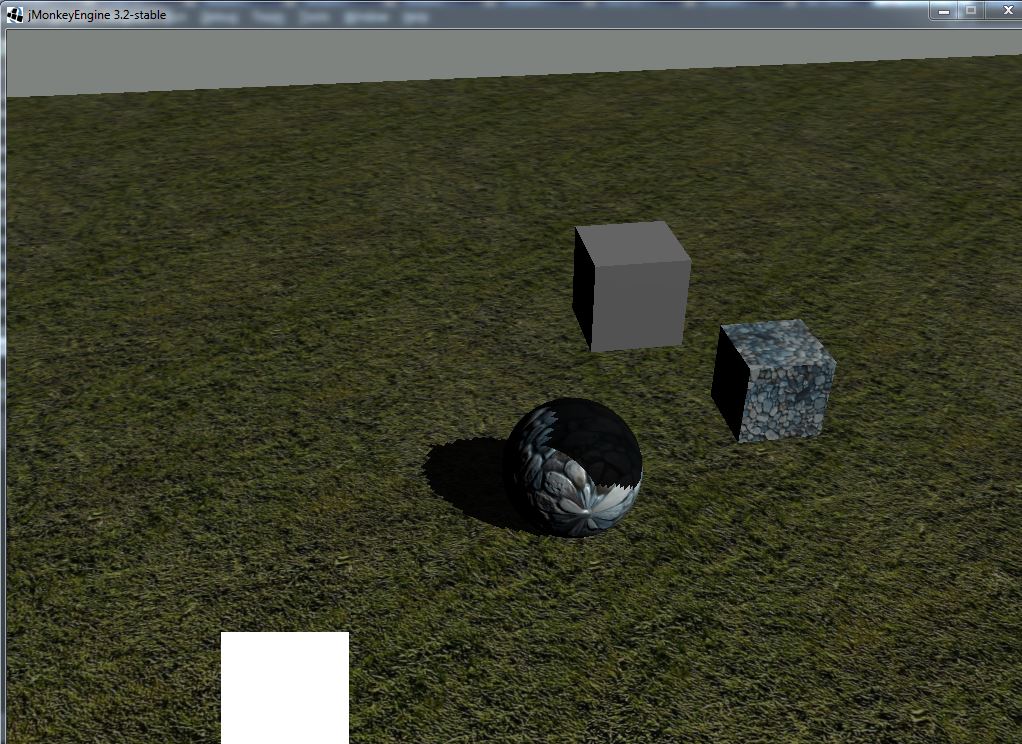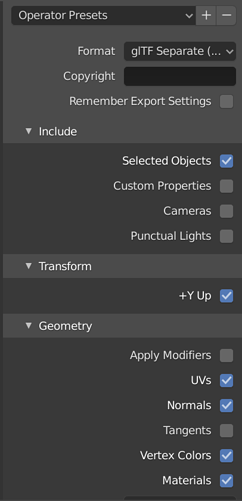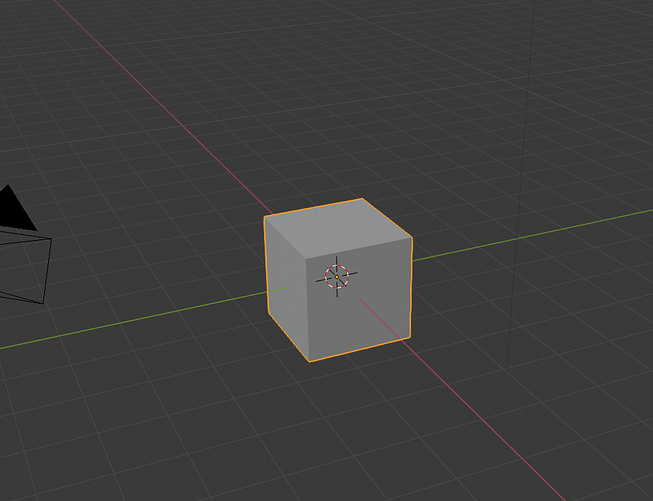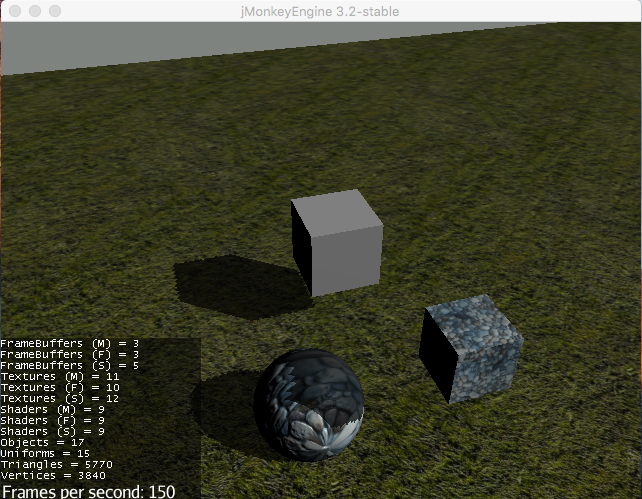Hi all !
Hope I’m not opening a topic already discussed a thousand times, I’ve been searching though quite a long time and am still struggling…
I’ve been trying to make shadows work with an imported cube, and for this purpose I’ve been testing stuffs with the LightShadow test, which in his basic version appears juste fine.
So I’ve kept two of these objects in the scene and tried to put my imported cube in the middle. And while the two others keep casting and receiving shadows just fine, my cube is still orphan of his own shadow.
I’ve tried with using the mesh.xml or scene to j3o, same result.
If anyone got any idea, i’d be really glad, cause i’ve been trying a thousand different things, including moving OS.
Here is the code :
package jme3test.light.testPerso;
import com.jme3.app.SimpleApplication;
import com.jme3.light.AmbientLight;
import com.jme3.light.DirectionalLight;
import com.jme3.material.Material;
import com.jme3.math.ColorRGBA;
import com.jme3.math.Quaternion;
import com.jme3.math.Vector2f;
import com.jme3.math.Vector3f;
import com.jme3.post.FilterPostProcessor;
import com.jme3.renderer.queue.RenderQueue.ShadowMode;
import com.jme3.scene.Geometry;
import com.jme3.scene.Spatial;
import com.jme3.scene.shape.Box;
import com.jme3.scene.shape.Sphere;
import com.jme3.shadow.DirectionalLightShadowFilter;
import com.jme3.shadow.DirectionalLightShadowRenderer;
import com.jme3.shadow.EdgeFilteringMode;
import com.jme3.texture.Texture;
import com.jme3.texture.Texture.WrapMode;
import com.jme3.util.SkyFactory;
import com.jme3.util.SkyFactory.EnvMapType;
import com.jme3.util.TangentBinormalGenerator;
public class TestDirectionalLightShadow extends SimpleApplication{
public static final int SHADOWMAP_SIZE = 1024;
private DirectionalLightShadowRenderer dlsr;
private DirectionalLightShadowFilter dlsf;
private Spatial[] obj;
private Material[] mat;
private Geometry ground;
private Material matGroundL;
private AmbientLight al;
public static void main(String[] args) {
TestDirectionalLightShadow app = new TestDirectionalLightShadow();
app.start();
}
//Charge la scene
public void loadScene() {
obj = new Spatial[2];
mat = new Material[2];
//obj0 set up
mat[0] = assetManager.loadMaterial("Common/Materials/RedColor.j3m");
obj[0] = new Geometry("sphere", new Sphere(30, 30, 2));
obj[0].setShadowMode(ShadowMode.CastAndReceive);
TangentBinormalGenerator.generate(obj[0]);
//obj1 type set up
mat[1] = assetManager.loadMaterial("Textures/Terrain/Pond/Pond.j3m");
mat[1].setBoolean("UseMaterialColors", true);
mat[1].setColor("Ambient", ColorRGBA.White);
mat[1].setColor("Diffuse", ColorRGBA.White.clone());
obj[1] = new Geometry("cube", new Box(1.0f, 1.0f, 1.0f));
obj[1].setShadowMode(ShadowMode.CastAndReceive);
TangentBinormalGenerator.generate(obj[1]);
//Basic objects
//Met une sphere de type obj0 dans le monde
Spatial t = obj[0].clone(false);
t.setLocalScale(10f);
t.setMaterial(mat[1]);
rootNode.attachChild(t);
t.setLocalTranslation(0, 25, 0);
Spatial t1 = obj[1].clone(false);
t1.setLocalScale(10f);
t1.setMaterial(mat[1]);
rootNode.attachChild(t1);
t1.setLocalTranslation(40, 70, 30);
//ground
Box b = new Box(1000, 2, 1000);
b.scaleTextureCoordinates(new Vector2f(10, 10));
ground = new Geometry("soil", b);
ground.setLocalTranslation(0, 10, 550);
matGroundL = new Material(assetManager, "Common/MatDefs/Light/Lighting.j3md");
Texture grass = assetManager.loadTexture("Textures/Terrain/splat/grass.jpg");
grass.setWrap(WrapMode.Repeat);
matGroundL.setTexture("DiffuseMap", grass);
ground.setMaterial(matGroundL);
ground.setShadowMode(ShadowMode.CastAndReceive);
rootNode.attachChild(ground);
//cube perso
//Spatial cube1 = assetManager.loadModel("Models/cube1/cube1.mesh.j3o");
Spatial cube1 = assetManager.loadModel("Models/gege2/gege.mesh.j3o");
cube1.setShadowMode(ShadowMode.CastAndReceive);
cube1.scale(15);
cube1.move(30, 50, -60);
rootNode.attachChild(cube1);
//set up directionalLight
l = new DirectionalLight();
l.setDirection(new Vector3f(-1, -1, -0.8f));
rootNode.addLight(l);
//set up sky
Spatial sky = SkyFactory.createSky(assetManager,
"Scenes/Beach/FullskiesSunset0068.dds", EnvMapType.CubeMap);
sky.setLocalScale(350);
rootNode.attachChild(sky);
}
DirectionalLight l;
@Override
public void simpleInitApp() {
//parametre la camera
cam.setLocation(new Vector3f(3.3720117f, 42.838284f, -83.43792f));
cam.setRotation(new Quaternion(0.13833192f, -0.08969371f, 0.012581267f, 0.9862358f));
flyCam.setMoveSpeed(100);
loadScene();//charge la scene
//PARAMETRAGE DU POST PROCESSING
//shadow renderer
dlsr = new DirectionalLightShadowRenderer(assetManager, SHADOWMAP_SIZE, 1);
dlsr.setLight(l);
//dlsr.setLambda(0.55f);
//dlsr.setShadowIntensity(0.8f);
dlsr.setEdgeFilteringMode(EdgeFilteringMode.Nearest);
dlsr.displayDebug();
viewPort.addProcessor(dlsr);
//shadow filter
dlsf = new DirectionalLightShadowFilter(assetManager, SHADOWMAP_SIZE, 1);
dlsf.setLight(l);
//dlsf.setLambda(0.55f);
//dlsf.setShadowIntensity(0.8f);
dlsf.setEdgeFilteringMode(EdgeFilteringMode.Nearest);
dlsf.setEnabled(true);
FilterPostProcessor fpp = new FilterPostProcessor(assetManager);
fpp.addFilter(dlsf);
viewPort.addProcessor(fpp);
}
@Override
public void simpleUpdate(float tpf) {
}
}
Thank you !!






